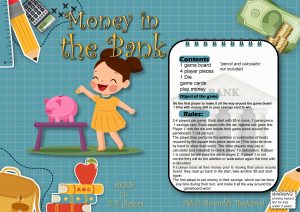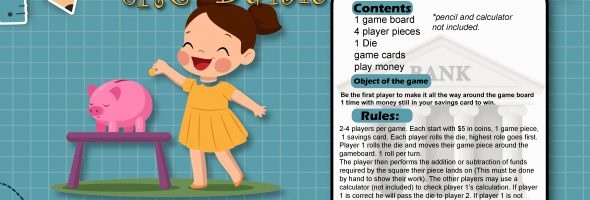Money in the Bank
Nick Kruks & Connor Waddell

Money drives the world’s economies, buys you a home, and gets you milk at the store. Love it or hate it, money has been around for centuries and doesn’t show any signs of leaving soon. To better prepare students for a world driven by cash for goods and services, teachers need to be able to integrate simple monetary teachings into their classroom lessons.
Children should be introduced to the idea of paying for goods and services as early as possible. According to the British Columbia Math curriculum, grade 1 is when the province feels students should become familiar with values associated with coins. Grade 2 students should be able to make combinations of money values up to $100.00, while in grade 3, they should learn about earnings and payment. In the grade we have chosen for our learning project, grade 4, students will begin to make change with dollar amounts up to $100.00. They will also begin to understand how to use addition and subtraction to calculate simple financial decisions.
To make these ideas more appealing to a grade 4 classroom, we have developed a math game we call Money in the Bank. Money in the bank is a Monopoly inspired board game that is designed to teach children ages 8 and up to add and subtract various sums of money, while they advance around the game board. The game touches on many facets of the current B.C. grade 4 math curriculum. Specifically, it addresses a student’s ability to add and subtract numbers with decimals to the hundredths column, use addition and subtraction in real-life contexts involving financial literacy and navigate simple financial decisions. All of this content aids in a student’s ability to understand the curriculum’s big idea of decimals being types of numbers that can represent quantities.
Money in the Bank will allow students to progress toward a deeper understanding of age appropriate math competencies. The game also connects to several curricular objectives including, “to develop, demonstrate, and apply mathematical understanding through play, inquiry, and problem solving” (BC Curriculum, 2020). Money in the Bank will also provide students the opportunity to communicate mathematical ideas using pictorial and symbolic forms. While they advance around the board, they are in constant communication with their classmates, verifying calculations and money amounts. Fake coin and bill denominations are provided for students to use during play. These will help students learn about adding to, and subtracting from, their savings to accrue enough funds to complete the game.
Students will be assessed through self-assessment during gameplay, formative teacher assessment during and after gameplay, and peer assessment during gameplay. Self-assessment skills will be utilized through verifying tabulations are correct with a paper and pencil, then a calculator. Peers will verify the calculations of fellow players’ totals with a calculator. This adds a level of fairness to the game, by all players being responsible for calculating exact totals. The teacher will formatively assess the student’s play by watching, listening and then discussing tabulations and gameplay at the end of a round.
After playing this game, it is expected that students will be able to complete the following “I can” statements:
- I can add and subtract numbers with decimals in the hundredths column.
- I can provide clear and positive feedback to my peers
- I can make proper change using monetary items
- I can play by the rules of a game and celebrate my efforts and accomplishments, whether I win or lose
- I can monitor my progress and adjust my actions to make sure I achieve what I want

